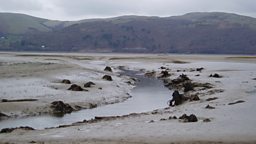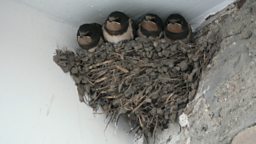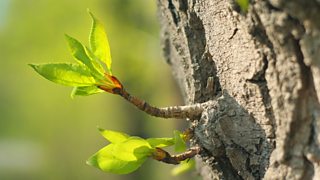11 clear reasons to love mud
is a programme dedicated to the wet, sludgy matter that is mud. Moving downriver from upland bogs to tidal mudflats, and passing through sheep fields, research field stations, village fêtes and battle fields along the way, we meet the people who make mud a way of life. Farmers, archaeologists, builders, ecologists and potters – as well as welly wangers and bog snorkelers – reflect on what mud means to them.
Here are 11 reasons to love soft, sticky soil. It’s as clear as mud.

1. Mud can be a useful tool in gardening
Mud can be an unwelcome curse for the gardener – if it’s too wet it can be impossible to work the land.
Mud was a key ingredient in creating the bricks that built some of the first great cities, like Babylon and Persepolis.
But mud can also lend a helping hand, as one gardener explains: “Say you’ve created a feature in someone’s garden, then you can use mud to press around what you’ve created and you get nice, clean, tight lines, so it finishes the job.”
Next time it rains, get out there and neaten up the edges of the patio.

2. Mud has brought about bog snorkeling
The World Bog Snorkeling Championship was first held in 1985, and now takes place every August Bank Holiday at the Waen Rhydd peat bog in Llanwrtyd Wells in Wales.
Enthusiastic swimmers cover 120 yards with their face immersed in muddy water. One fan explains how “the rules are that you can’t swim breast stroke or crawl, you can only use your flippers and your arms just to paddle.”
He recounts being unable to see anything through the brown sludge, including the bog’s wildlife: water scorpions, leeches and trout. Flipping ‘ell!
3. Mud is an important habitat for wildlife
Kate Baker, a research fellow at the Centre for Water Systems at the University of Exeter, explains how rivers wind through our valleys, collecting material as they go.

The sediment and the mud can then be a really important habitat for creatures like mayflies, stoneflies, and dragonflies.
When it hits the ocean the suspended sediment creates mudflats and estuaries, a home for cockles and a plethora of birds like the Oystercatcher, who feeds on the bountiful store of invertebrates and shellfish.
4. Mud can tell us how much energy is in a river
Kate Baker explains how “you can just look at the colour of the river” and that will tell you how quickly it’s moving: if it’s fast flowing it has enough energy to pick up the suspended sediment and will turn brown; a slow flowing river will be clear with the sediment visible at the bottom.
We hope that’s clear.

5. Mud protects against rising sea levels
Dr Rob Barnett at the University of Exeter explains the strong relationship between the elevation of a salt marsh surface and the height of sea level – as sea level rises there is more space for mud to accumulate.
Over time, “with the accumulation of all this mud you have a record of sea level changes” and we can see that the rate of sea level rise over the last two hundred years is “unprecedented”.
But, reassuringly, “the natural environment is pretty well prepared” to protect against sea level rise, with sediment being deposited and accumulated quickly as the water levels go up.
Thank mud for that.

6. Mud was the magic ingredient that created human civilization
It is thought that we stopped wandering and learnt to make our food grow around us, instead of trekking about after it, in the fertile crescent formed by the flood plains of the Nile, the Euphrates and the Tigris.
Annual floods kept these plains irrigated and mineral rich, and out of the same mud came the bricks that built the great cities of the region like Babylon and Persepolis – the first large scale engineering projects.

7. Mud is a natural fertiliser
There are instances where bird nests made of earth have been reused for almost half a century.
Neolithic farmers learnt the value of mineral rich mud and river sediment, and it is still used today as natural fertiliser. As Harry Clark, an archeologist from the Museum of London, says, “mud is where life springs from.”
8. Mud can be used to build houses
Cob is a natural building material made from subsoil, water, and fibrous organic material like straw. Because of the thick walls, a cob house will be warm in winter and cool in summer, and it will easily survive a storm or two – the oldest cob house still standing is 10,000 years old!
9. Birds use mud to make their homes too
Some birds, like the swallow, use earth and spit to construct nests against the beams or shelves in buildings or on cliff ledges.
They collect mud pellets in their beaks and use them like little building blocks for their small homes. Like our cob houses, mud nests are durable and existing nests are often refurbished.
There are instances where nests have been reused for almost half a century.

10. Mud is used to produce pots
Potters are potty about one type of mud. Clay is a very fine-grained soil that is plastic (meaning it’s soft and pliable) when moist and can be moulded into useful shapes, like pots and plates, when wet. These are then baked or left to dry naturally in the sun to become hard. When fired at extreme temperatures, clay can be a long-lasting building material used to make tiles for housing.
11. Without mud we wouldn鈥檛 have welly wanging
It was the first Duke of Wellington who dreamt up the welly in the mid-nineteenth century. Without him, and without the mud that inspired his sartorial invention, we would not have the very British pastime of welly wanging.

The Welly Wanging World Championships are held each year in the town of Upperthong in West Yorkshire, where competitors are required to hurl a Wellington boot as far as possible within boundary lines, sticking to very strict rules and regulations.
Give it some welly!




